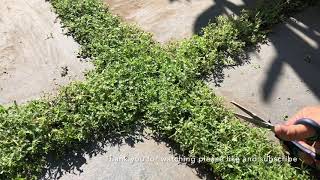To plant creeping thyme between pavers, prepare the soil by removing any weeds and debris. Then, place the pavers, leaving a small gap between them.
Afterward, dig holes in the gaps, ensuring they are wide and deep enough to accommodate the thyme plants. Finally, place the thyme plants into the holes, tamp down the soil firmly, and water them thoroughly. If you’re looking to enhance the beauty and functionality of your outdoor space, planting creeping thyme between pavers can be a delightful solution.
This low-growing perennial herb not only adds a touch of elegance to your walkways but also releases a soothing fragrance when stepped upon. Additionally, thyme is a versatile plant that thrives in various climates and is relatively low-maintenance. However, proper installation is essential to ensure its successful growth. In this guide, we’ll provide you with clear and actionable steps on how to plant creeping thyme between pavers, allowing you to enjoy a vibrant and aromatic pathway for years to come.

Credit: www.reddit.com
How to Plant Creeping Thyme between Pavers: Step by Step Guide
Selecting The Right Location For Your Creeping Thyme Garden
Selecting the perfect spot for your creeping thyme garden is crucial for its success. Consider the amount of sunlight and the soil conditions in that area. Evaluating the space between your pavers is also important for deciding where to plant your creeping thyme.
Make sure to choose a location that receives enough sunlight for the plants to thrive. Additionally, check the soil conditions to ensure they are suitable for the creeping thyme. Take the time to observe the area between your pavers and find a spot that has good drainage.
By following these guidelines, you will be able to find the right location for your creeping thyme garden and ensure its healthy growth.
Preparing The Soil For Planting Creeping Thyme
Preparing the soil for planting creeping thyme involves clearing debris and removing weeds. It’s important to create a healthy environment for the thyme to thrive. Start by clearing any debris and removing any weeds that may hinder growth. Next, focus on improving soil drainage.
Well-drained soil will prevent water from pooling around the plants and promote healthy growth. Use a garden fork to loosen the soil and remove any compacted areas. Now the soil is ready for planting creeping thyme between the pavers. Remember to space the plants appropriately, follow the planting instructions, and provide regular watering and maintenance for successful growth.
By taking these steps, you can create a beautiful and aromatic thyme-filled pathway.
Planting Creeping Thyme Between Pavers
Planting creeping thyme between pavers is a great way to add charm and fragrance to your garden. When preparing thyme seedlings, make sure to choose healthy and well-rooted plants. Before planting, create a planting pattern by spacing out the pavers to leave room for the thyme.
Dig small holes between the pavers, ensuring they are deep enough to accommodate the root system. Gently remove the thyme from its container and place it into the hole, firming the soil around it. Water the thyme thoroughly after planting to help settle the soil and promote root growth.
Once established, creeping thyme requires minimal maintenance, making it an ideal choice for busy gardeners. With its low-growing habit and delightful blooms, planting creeping thyme between pavers will transform your outdoor space into a fragrant oasis.
Maintaining And Caring For Your Creeping Thyme Garden
Creeping thyme is a beautiful ground cover that can be planted between pavers to create a unique and fragrant garden. To maintain and care for your creeping thyme garden, it’s important to follow a few tips. When it comes to watering, make sure to provide enough moisture without over-soaking the soil.
Additionally, regular fertilizing will help the thyme to grow and thrive. To prevent overgrowth, prune the thyme to keep it in control and maintain its shape. By following these watering and fertilizing tips, as well as pruning regularly, you can keep your creeping thyme garden looking its best throughout the year.
So go ahead, plant some creeping thyme between your pavers and create a beautiful and easy-to-maintain garden space.
Troubleshooting Common Issues With Creeping Thyme
Creeping thyme makes a beautiful addition to walkways and patios when planted between pavers. However, like any plant, it can encounter issues such as pests and diseases. To tackle these problems, start by keeping an eye out for pests like aphids or spider mites, and promptly take action to eradicate them.
Diseases like root rot can be controlled by ensuring proper drainage and using well-draining soil. Additionally, managing weed growth is crucial to prevent competition for nutrients and water. Regularly pull out any unwanted plants or use organic mulch to smother them.
By troubleshooting and addressing these common issues, you can successfully plant creeping thyme between pavers and enjoy its vibrant beauty in your outdoor spaces.
Enhancing The Aesthetic Appeal Of Your Creeping Thyme Garden
Enhancing the aesthetic appeal of your creeping thyme garden involves incorporating different thyme varieties and combining them with complementary plants. By selecting a variety of thyme types, such as lemon thyme or woolly thyme, you can introduce a diverse range of colors, textures, and scents to your garden.
These variations will add visual interest and create a dynamic and vibrant landscape. Additionally, interplanting your creeping thyme with other plants, such as low-growing succulents or colorful groundcovers, will provide contrast and enhance the overall beauty of your garden. Consider planting creeping thyme between pavers to create a soft and inviting pathway.
The thyme will spill over the edges of the pavers, softening the hardscape and adding a whimsical touch to your outdoor space. By following these simple guidelines, you can create a stunning and visually pleasing creeping thyme garden.
Frequently Asked Questions On How To Plant Creeping Thyme Between Pavers
Is Creeping Thyme Good Between Pavers?
Yes, creeping thyme is a good choice for filling the spaces between pavers. It forms a dense, low-growing mat that effectively suppresses weeds and prevents erosion. Creeping thyme also releases a fragrant aroma when stepped on, adding an inviting touch to your outdoor space.
It thrives in full sun and well-drained soil, making it ideal for growing between pavers. Additionally, creeping thyme is a drought-tolerant plant, requiring minimal water once established. It is low-maintenance and does not require frequent mowing or trimming. With its attractive foliage and tiny lavender or pink flowers that bloom in summer, creeping thyme adds beauty to your pathway or patio.
Overall, creeping thyme is a practical and aesthetically pleasing choice for filling the gaps between pavers.
How Do You Plant Between Concrete Pavers?
Planting between concrete pavers is a simple process. Clear any debris from the gaps between the pavers using a brush or blower. Next, spread a layer of sand or fine gravel over the surface of the pavers, making sure to fill the gaps evenly.
Use a broom to sweep the sand or gravel into the gaps, ensuring that each gap is completely filled. Afterward, compact the surface with a tamper or by walking over it. This will help settle the sand or gravel and create a stable base.
Finally, choose the desired plants for the gaps. Opt for low-growing, durable plants that can withstand foot traffic and adapt to the growing conditions. Place each plant into the gaps, firm the soil around them, and water thoroughly. Regularly maintain the plants by trimming excess growth and removing any weeds.
With these steps, you can enjoy a beautiful and well-maintained landscape between your concrete pavers.
How Do You Plant Ground Cover Around Pavers?
Planting ground cover around pavers is a simple process that can enhance the beauty of your outdoor space. Start by selecting a ground cover that is suitable for your climate and the amount of sunlight the area receives. Remove any existing vegetation or weeds before planting.
Dig small holes around the pavers and place the ground cover plants in the holes. Space the plants according to their growth requirements. Water the plants thoroughly after planting to help them establish roots. Mulch can be added to retain moisture and suppress weeds.
Regularly check for weeds and remove them promptly. Prune the ground cover as necessary to keep it tidy and prevent it from overgrowing onto the pavers. With proper care and maintenance, your ground cover will flourish and create a beautiful and inviting outdoor space.
Can I Just Scatter Creeping Thyme Seeds?
No, it is not recommended to scatter creeping thyme seeds. Instead, it is best to plant them in a controlled manner.
Conclusion
To sum it up, planting creeping thyme between pavers is a practical, visually appealing, and low-maintenance landscaping choice. This versatile herb not only adds a touch of beauty to your outdoor space but also releases a pleasant fragrance when stepped on.
Follow the simple steps outlined in this guide to ensure proper placement and growth of your creeping thyme. By preparing the soil well, spacing the pavers correctly, and providing ample sunlight and proper drainage, you can create a stunning thyme-filled pathway or patio.
With its ability to withstand foot traffic and its potential for weed control, creeping thyme is an excellent choice for enhancing the beauty and functionality of your outdoor space. So, get your gardening gloves on and enjoy the beauty and benefits that planting creeping thyme between pavers can bring to your landscape.
Happy gardening!

